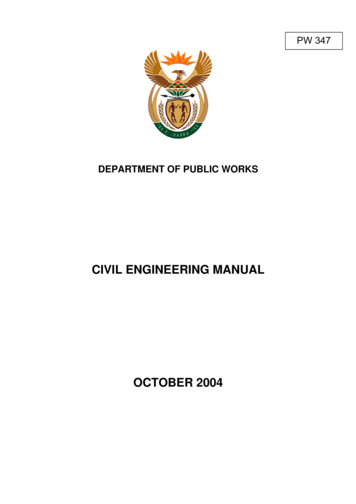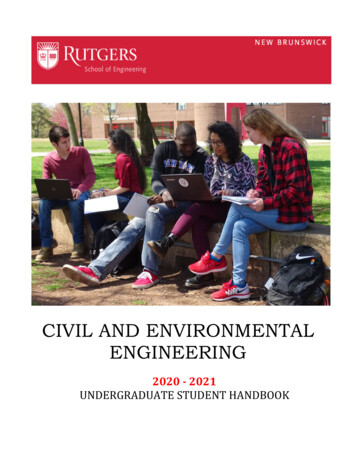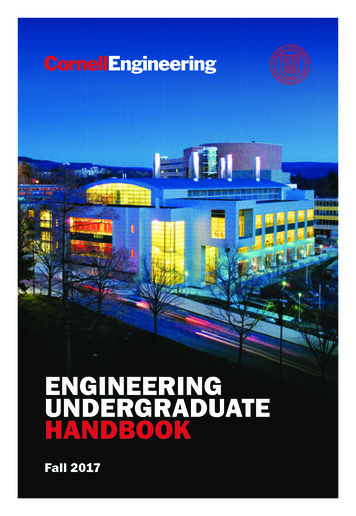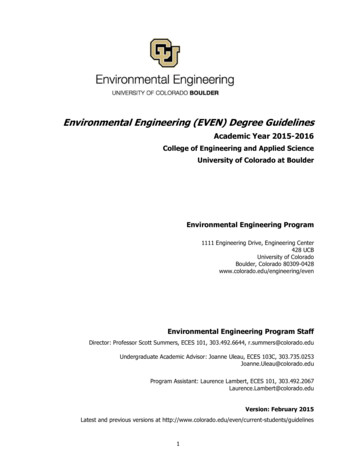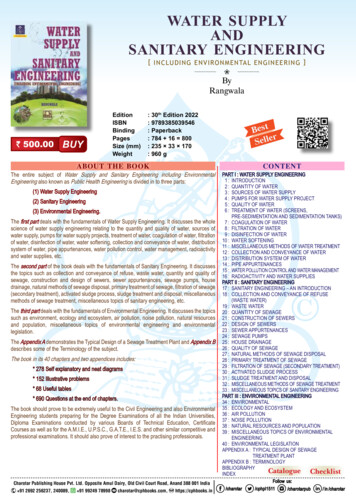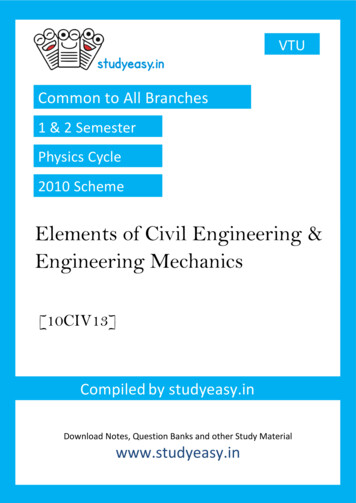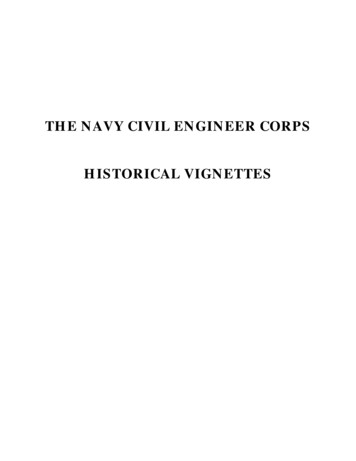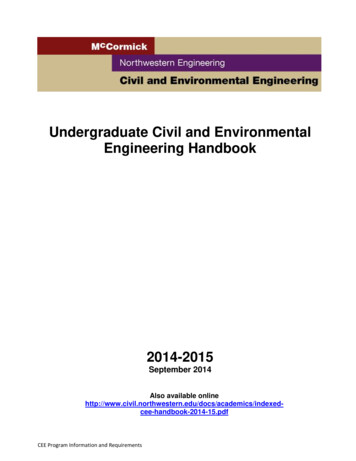
Transcription
Undergraduate Civil and EnvironmentalEngineering Handbook2014-2015September 2014Also available mics/indexedcee-handbook-2014-15.pdfCEE Program Information and Requirements
Name:Campus Address:Phone:E-mail:Faculty Advisor:Office/E-mail:**************Important Notice to All Advisees******************Please bring the following information with you when you meetwith your advisor:CEE Program Information and Requirements29-2014
Academic Time TableYEAR 1WhatWhenLearn about civil and environmentalengineering (CEE) majorsStart in Fall quarterDeclare majorPlan for sophomore year curricula(BSCE and BSEE)Begin completing social science andhumanity themeExplore certificate programs, multiplemajors, minors, BS/MSLearn more about the CEE professionand meet with practitionersHowMeet with Professor Dowding (Tech A122, cdowding@northwestern.edu) for civil engineeringand Professor Gaillard (Tech A324, jfgaillard@northwestern.edu) for environmentalengineering; speak with upper division students(Tech AG 52), attend NU ASCE(asce.mccormick.northwestern.edu) and EnvEUS(enveus.mccormick.northwestern.edu) eventsFall quarterTake CivEnv 195 Introduction to Civil &Environmental Engineering, a zero credit course.Winter quarterAttend McCormick Department FairthPreferably by 4 week of Submit McCormick Freshman Declaration orSpring quarterChange of Major Form, page 63, to McCormickAcademic Services (Tech L269)Spring quarterAttend CEE Rising Sophomore Advising SeminarCan be as early as fallquarter of year 1 andshould not be later thanspring quarter of year 2Can be as early as Fallquarter of year 1Start at Evening withMcCormick during fallorientation weekDiscuss with your academic advisor; speak withupper-division students (NU ASCE and EnvEUSmembers); submit McCormick Social Sciences/Humanities Theme Declaration Form, page 56 toMcCormick Academic Services (Tech L269)Discuss with your academic advisorJoin and be an active member of NU ASCE(asce.mccormick.northwestern.edu) or EnvEUS(enveus.mccormick.northwestern.edu) activities;attend job fairsExplore part time researchStart in Fall quarterGo to CEE department office (Tech A236) to inquire;opportunities in CEE departmentspeak with upper division CEE students (NU ASCE orEnvEUS) to inquire their experience; speak with CEEfaculty to learn their research activitiesFind summer internship in engineering Start in Fall quarterVisit NU ASCE or EnvEUS websites(asce.mccormick.northwestern.edu orenveus.mccormick.northwestern.edu) on internshiplists; attend NU ASCE or EnvEUS meetings oninternship; speak with upper–classmen; exploreemployer contact list in CEE website; meet withMcCormick Office of Career Development (MCD)advisor; register with McCormick McCormickConnect/index.html); take a careerdevelopment course CRDV 301 (a zero credit, notuition course)Start in mid-fallVisit potential employers while home during holidaybreaksJanuaryparticipate in CEE Career FairWinter & spring quarters Take GenEng 220-1,2Explore fellowships such as Fulbright,Spring quarterVisit Office of FellowshipsBarry Goldwater, /index.html)CEE Program Information and Requirements39-2014
Academic Time TableYEAR 2WhatWhenHowTransfer major from other engineering Nowprograms or WeinbergComplete social science and humanitythemeContinue from Year 1Explore certificate programs, multiplemajors, minors, BS/MSLearn more about the CEE professionand meet with practitionersContinue from Year 1Explore part time researchopportunities in CEE departmentContinue from Year 1Find summer internship in CEEStart in Fall quarterContinue from Year 1Start in mid-fallJanuaryContinue from Year 1Start in the fall quarterExplore co-op programsStarts in the FallquarterApply for external scholarshipssponsored by professional and otherorganizationsWinter and SpringquartersCEE Program Information and Requirements4Meet with staff in McCormick Academic Services(Tech L269); meet with Professor Dowding (TechA122, c-dowding@northwestern.edu) for civilengineering and Professor Gaillard (Tech A324, jfgaillard@northwestern.edu) for environmentalengineering; submit McCormick Change ofMajor/Change of Catalog Year Form, page 65, toMcCormick Academic Services (Tech L269)Discuss with your academic advisor; speak withupper-division students (NU ASCE and EnvEUSmembers); submit McCormick Social Sciences/Humanities Theme Declaration Form, page 56, toMcCormick Academic Services (Tech L269)Discuss with your academic advisorJoin and be an active member of NU ASCE(asce.mccormick.northwestern.edu) or EnvEUS(enveus.mccormick.northwestern.edu) activities;attend job fairsGo to CEE department office (Tech A236) to inquire;speak with upper division CEE students (NU ASCE orEnvEUS) to inquire their experience; speak with CEEfaculty to learn their research activitiesvisit NU ASCE or EnvEUS websites(asce.mccormick.northwestern.edu orenveus.mccormick.northwestern.edu) on internshiplists; attend NU ASCE or EnvEUS meetings oninternship; speak with upper–classmen; exploreemployer contact list in CEE websiteVisit potential employers while home during holidaybreaksparticipate in CEE Career FairMeet with McCormick Office of Career Development(MCD) advisor; register or visit McCormick McCormickConnect/index.html) and check job availability;or take a career development course CRDV 301 (azero credit, no tuition course)Take CivEnv 195 Introduction to Civil &Environmental Engineering and GenEng 220-1,2 ifnot taken in Year 1Meet with MCD advisor; register with .edu/mcd/McCormickConnect/index.html) and check job availability;take a career development course CRDV 301 (a zerocredit, no tuition course)Information disseminated through CEE website andNUASCE and EnvEUS listserv and websites.9-2014
Academic Time TableYEAR 2WhatWhenHowExplore Study AbroadFall quarter, seedeadlines posted onStudy Abroad OfficewebsiteStart in Fall quarterVisit Study Abroad ex.html); discuss with your academic advisorExplore or apply fellowships such asFulbright, Barry Goldwater, and othersCEE Program Information and Requirements5Visit Office of s/about/index.html)9-2014
Academic Time TableYEAR 3WhatWhenHowExplore Architectural Engineering &Design (AED) or interested in AEDCertificateStart in Fall quarter for 3 Begin taking CivEnv 385-1 and continue ontoquartersCivEnv 385-2 in the Winter quarter and CivEnv 3853 in the Spring quarter; co-requisite: CivEnv 221 for385-1 in the Fall and CivEnv 325 for 385-2 in theWinterTransfer major from other engineering Now may be challenging; Meet with a staff in McCormick Undergraduateprograms or Weinbergit may not be possible to Engineering Office (Tech L269); meet withfulfill the BSCE or BSEEProfessor Dowding (Tech A122, crequirements in the rest dowding@northwestern.edu) for civil engineeringof year 3 and year 4and Professor Gaillard (Tech A324, jfwithout taking extragaillard@northwestern.edu) for environmentalclassesengineering; complete McCormick Change ofMajor/Change of Catalog Year Form, page 65Complete social science and humanity Continue from Years 1Complete McCormick Social Sciences/ Humanitiesthemeand 2Theme Declaration Form, page 56; discuss withyour academic advisor; speak with upper-divisionstudents (NU ASCE and EnvEUS members)Develop spreadsheet plans toNow; multiple majors,Discuss with your academic advisor; develop yourcomplete certificate programs,minors, or certificatecurriculum plan (see pages 54, 55)multiple majors, minors, BS/MSprograms will requiredetailed planningExplore writing an Honor thesisFall quarterSpeak with faculty in your area(s) of interest toidentify a thesis advisor. There are special courserequirements. Consult with your academic advisor.Learn more about the CEE professionContinue from Years 1Join and be an active member of NU ASCEand meet with practitionersand 2(asce.mccormick.northwestern.edu) or EnvEUS(enveus.mccormick.northwestern.edu) activities;attend job fairsRekindle exploration of part timeStart in Fall quarterGo to CEE department office (Tech A236) toresearch opportunities in CEEinquire; speak with upper division CEE studentsdepartment(NU ASCE or EnvEUS) to inquire their experience;speak with CEE faculty to learn their researchactivitiesBegin next cycle of finding summerStart in Fall quartervisit NU ASCE or EnvEUS websitesinternship in CEE(asce.mccormick.northwestern.edu orenveus.mccormick.northwestern.edu) oninternship lists; attend NU ASCE or EnvEUSmeetings on internship; speak with upper–classmen; explore employer contact list in CEEwebsiteStart in Fall quarter ifMeet with MCD advisor; register with McCormickyou didn’t do it in Year 1 Connector Year ickConnect/index.html) and check jobavailability; take a career development courseCRDV 301 (a zero credit, no tuition course)CEE Program Information and Requirements69-2014
Academic Time TableYEAR 3WhatWhenHowBegin next cycle of finding summerinternship in CEE (continue)Start in November or fallquarter breakJanuaryContinue from Year 2Visit potential employers while home duringDecember holiday breakparticipate in CEE Career FairMeet with an advisor in MCD; register withMcCormick McCormickConnect/index.html) and check jobavailability; take a career development courseCRDV 301 (a zero credit, no tuition course)Information disseminating through CEE websiteand NUASCE and EnvEUS listserv and theirwebsites.Submit McCormick Application for Bachelor’sDegree to McCormick Academic Services (TechL269)Use appropriate declaration or intent to pursueform in CEE UG handbook if minor or certificateprogram is in CEE; otherwise, use forms fromdepartment/college houses minor or certificationprogram.Study for and take GRE exam by OctoberVisit potential graduate schoolsContinue co-op programs planningApply for external scholarshipssponsored by professionalorganizations and other organizationsApply for graduationWinter and SpringquartersDeclare minors and certificates inMcCormickWinter quarterWinter quarterExplore graduate schoolStart in Winter quarterQuarter break andsummerApply for fellowships such as Fulbright, If haven’t started in FallBarry Goldwater, and othersquarter, the sooner thebetterExplore dual BS/MS program if GPA Within 4 courses from3.50completing BS degreeCEE Program Information and Requirements7Go to Office of s/about/index.html)Discuss with MS program rgraduate/BS MS/index.html); meet with Dr. Bruce Lindvall,Assistant Dean for Graduate Studies in McCormick(Tech L261, b-lindvall@northwestern.edu); submitTGS Combined Degree Program form to Dr.Lindvall9-2014
Academic Time TableYEAR 4Fundamentalof Engineering(FE) examWhatReviewApplicationExamApply to Graduate schoolWhenHowWinter and springquartersGo to NCEES.orgJan/Feb, Apr/May,July/Aug, Oct/Nov ofeach yearFall quarterFall quarterFall and Winter quartersand spring breakTake CivEnv 301-1,2 and borrow the FE reviewbook from CEE DepartmentRegister to take the examvisit NCEES.org for more information; exam isadministrated online by NCEESExplore graduate external fellowshipssuch as NSF Research Fellow, SMARTFellow, etc. for those interested inpursuing Ph.D.Fall quarterExplore dual BS/MS program if GPA 3.50Within 4 courses fromcompleting BS degreeLook for full time jobsFall quarterFall quarterStart in mid-fallApply for external scholarships forgraduate studies sponsored byprofessional organizationsJanuaryWinter and SpringquartersCEE Program Information and Requirements8Submit your applicationsTake GREVisit the campus; meet the graduate programcoordinator, students and faculty at schools youare interested inCheck ASEE web sites for deadline; go to Office ips/about/index.html); speak with other Fellows inMcCormick; visit NU Office of Fellowship forassistance.Discuss with MS program rgraduate/BS MS/index.html); meet with Dr. Bruce Lindvall,Assistant Dean for Graduate Studies in McCormick(Tech L261, b-lindvall@northwestern.edu); submitTGS Combined Degree Program form to Dr.LindvallVisit NU ASCE or EnvEUS websites on job lists;submit resume to IL ASCE resume book; attend ILASCE or other professional meetings (networking);go to engineering firm open houses.Register with McCormick McCormickConnect/index.html) and check forcompanies that have hired CEE before or jobavailabilityVisit potential employers while home duringholiday breaksparticipate in CEE Career FairInformation disseminated through CEE website andCEE student organization listserv and websites.9-2014
PrefaceThis handbook is intended to provide you with a comprehensive guide to the Civil andEnvironmental Engineering programs in the Department of Civil and Environmental Engineering(CEE), McCormick School of Engineering and Applied Science (MEAS), at Northwestern University.We hope this handbook will enhance your learning experience at Northwestern.The information provided in this handbook is based on the 2014-2015 NorthwesternUndergraduate Catalog. Information for catalog years since 2010-11 are available ate/civil engineering/civil curriculum.html, environmental engineering/environmental curriculum.html for, respectively, Civil Engineering and Environmental Engineering.This handbook is prepared as a handy reference guide to the degree requirements,programs, policies, and procedures of the Department, School, and University. An Academic TimeTable in pages 3-8 is provided to guide you through various milestones during the 4 year program.We hope that you will find the information you need for both planning and understanding yourengineering education.The Department would also like to emphasize the importance of the social and ethicalimplications of the engineers' work in the betterment of the society. The CEE Department offerstwo ABET accredited engineering programs, Bachelor of Science in Civil Engineering (BSCE) and theBachelor of Science in Environmental Engineering (BSEE). We also offer a minor in EnvironmentalEngineering and a Certificate program in Architectural Engineering and Design (AED).At Northwestern University, you will have the opportunity to experience professionalactivities and diverse cultures from student professional organizations and the many ethnic groupsamong our students and faculty. The CEE Department has two student organizations devoted toprofessional development and interaction. They are the Northwestern University American Societyof Civil Engineers (NU ASCE) student chapter and EnvEUS (Environmental EngineeringUndergraduate Students). You will also have an opportunity to explore outside the U.S. throughthe Study Abroad Program and many student projects around the globe through the various studentorganizations such as the Engineers for the Sustainable World and the Global Architectural Brigades.We encourage you to seek out and explore courses and activities that will enrich your learningexperience during your time at Northwestern.Although this handbook embraces the development of an undergraduate engineeringeducation, it does not constitute a complete or definitive statement of the policies of NorthwesternUniversity and McCormick School of Engineering and Applied Sciences. The NorthwesternUndergraduate Catalog 2014-2015 is the official document of the University for defining academicprograms and requirements. The final authority for academic degree requirements of BSCE andBSEE is jointly administered by the faculty of the MEAS, McCormick School Curriculum Committee,and the faculty of the CEE Department. Furthermore, the curricula of both the BSCE and BSEEdegrees must be in compliance with the ABET accreditation requirements.We hope you find this handbook a useful resource as you progress through your years atNorthwestern. We wish you much success and welcome your suggestions for improvement of thehandbook.Jianmin Qu, Ph.D.Walter P. Murphy Professor and ChairCivil and Environmental EngineeringCEE Program Information and Requirements
Responsibility for Meeting Degree RequirementsUltimately, students are responsible for understanding the degree requirements for their majorsand for planning their courses of study accordingly. The McCormick School UndergraduateEngineering Office serves as an invaluable resource for information and assistance regardingcourses, registration, majors, study abroad, your degree progress, and more. Faculty advisorsassigned to you will assist in course selection, but they are not responsible for ensuring that thecourses selected meet degree requirements. That is the responsibility of the student.CEE Program Information and Requirements109-2014
Table of ContentsAcademic Time Table. 3Preface . 9Responsibility for Meeting Degree Requirements . 10Introduction . 13Missions . 14Civil and Environmental Engineering . 15Civil Engineering Profession . 15Employment. 175Job Outlook . 186Earnings . 186Environmental Engineering Profession . 17Employment. 17Job Outlook . 18Earnings . 18Student Organizations . 19Internship and Career Development . 20Scholarships . 20Undergraduate Research. 20Academic Advising . 21What to Expect from an Advisor . 21What Not to Expect from an Advisor. 22Student Responsibilities in the Student-Advisor Relationship . 23Bachelor of Science in Civil Engineering (BSCE). 24Program Educational Objectives . 24Student Learning Outcomes. 24Table CE.1 Mapping of BSCE Program Educational Objectives and Student Learning Outcomes . 25Program Requirements . 26Table CE.2 Sample BSCE Curriculum Flow Chart . 33Table CE.3a Suggested Electives for BSCE Architectural Engineering Concentration 2014-2015 . 35Table CE.4 Summary of MTS and ET Topic Units in BSCE . 38Table CE.5 BSCE Program Check-Off Sheet . 39Bachelor of Science in Environmental Engineering (BSEE) . 40Program Educational Objectives . 40Student Learning Outcomes. 40Program Requirements . 43Table EE.2 Sample BSEE Curriculum Flow Chart . 49Table EE.3 Summary of MTS and ET Units in BSEE . 50Table EE.4 BSEE Program Check-Off Sheet. 51Minor in Environmental Engineering . 52Architectural Engineering and Design Certificate Program . 53Required Courses for all Engineers . 53Tables and Forms . 55Contact Information . 93Department of Civil and Environmental Faculty . 93Who to see for questions on academic issues . 95CEE Program Information and Requirements119-2014
Tables and FormspageGroup 1: for all civil and environmental engineering majorsUndergraduate Curriculum PlanSample 5-year plan for BSCE and BS in Music of a BSCE studentSocial Sciences/Humanities Theme FormCiv Env 399 Project Application for an Independent Study FormUndergraduate (Departmental) Honor ProgramsApplication for Bachelor's DegreeDual Engineering Degree Form (with EA/DTC)Dual Engineering Degree Form (without EA/DTC)Waling in GraduationTGS Combined Degree (BS/MS) Program FormFreshman Declaration or Change of Major FormChange of Advisor ConfirmationChange of Major/Change of Catalog Year Form (sophomore year & above)Registration Time Conflict Permission FormCurriculum Petition FormTransfer Credits to NU for College-Level Course Work Completed prior toGraduation from High SchoolTransfer Credits to NU for College-Level Course Work Completed at OtherInstitutionsPetition Form for Majors/Minors Pursued Outside of McCormickApplication for Inter-School Transfer or Dual BS Degree ProgramGroup 2: for civil engineering majorSummary of MTS and ET Topic Units in BSCEBSCE Program Check-Off SheetGroup 3: for environmental majorSummary of MTS and ET Topic Units in BSEEBSEE Program Check-Off SheetGroup 4: Certificate and minor programs offered in CEEIntent and Declaration Form: Minor in Environmental EngineeringIntent to Pursue the Certificate in Architectural Engineering and DesignDeclaration of Petition to Receive Certificate in Architectural Engineering andDesignCEE Program Information and 85868788899091929-2014
IntroductionWelcome to the Department of Civil and Environmental Engineering (CEE), McCormick School ofEngineering and Applied Science at Northwestern University. The faculty and students at CEE lookforward to interact with you so that you can enjoy the maximum learning, social, and culturalexperience Northwestern University can offer you. This handbook is part of our effort to help youachieve this goal from the academic aspect. In addition to academic requirements, this handbookincludes an academic time table of some milestones such as declaration of major, internship, etc.,that would guide you through your chosen program(s). We hope you will thoroughly read thishandbook at least once to see the types of information included here. We also hope that you willrefer to it whenever you have an academic related question. Of course, our faculty and your peersare available to address any issue you may have. Please feel free to contact them.A new edition of the handbook is published annually to coincide with each academic year andundergraduate catalog. Revisions will be made as needed each quarter. The modifications will bedenoted by vertical lines at the left hand margins for easy referencing. First revision is denoted bysingle vertical line. Second revision is denoted by double vertical lines. Third revision is denoted bydouble vertical lines with one being a heavy thickness line. Revision number and dates are shownon the cover page. The handbook is also available mics/indexed-cee-handbook-2014.pdfTo assist us in the continuing effort to improve this document, please send your suggestions andcomments to Professor Karen Chou, Assistant Chair & Clinical Professor at karenchou@northwestern.edu.CEE Program Information and Requirements139-2014
MissionsNorthwestern UniversityNorthwestern is committed to excellent teaching, innovative research, and thepersonal and intellectual growth of its students in a diverse academic community.McCormick School of Engineering and Applied ScienceThe mission of the Robert R. McCormick School of Engineering and Applied Science is toachieve excellence at all levels of engineering education, research, and practice. Fromundergraduate and graduate students to faculty and staff, the McCormick community isengaged in the creation, exploration and application of engineering and scientific principlesto the solution of problems and the advancement of society. With a solid grounding onfundamentals and a balance between adaptability and collaboration and analysis andcreativity, the McCormick School partners with industry, government, the Northwesterncommunity and peer institutions in pursuit of its mission.Department of Civil and Environmental EngineeringWe empower our students to gain technical, design, and management skills neededfor leadership. We emphasize fundamental principles and design methods that applyto many career paths. We conduct research that advances our ability to:1. Plan, design, construct, and operate society's infrastructure2. Design and control behavior of materials3. Sustain natural and engineered environmental systemsWe achieve this through basic and applied projects in which students and facultywork together in cutting-edge facilities.The above mission statements can be found on the websites:University – http://www.northwestern.edu/provost/McCormick dership/vision statement/index.htmlDepartment – http://cee.northwestern.edu/about/mission.htmlCEE Program Information and Requirements149-2014
Civil and Environmental EngineeringCivil Engineering ProfessionCivil Engineering is an international profession that provides solutions for pressing societalchallenges for both the natural and built environment as shown in the video on our web te/civil engineering/index.html. Civilian infrastructuresystems provide safe drinking water, sustainable energy, efficient mobility, and sequestered ortreated waste. They transform wastelands and protect against natural disasters. Civil engineersdesign, construct, and manage these systems as well as the taller, longer, lighter, and more elegantstructures at the ends nodes, such as airports, sky scrapers, bridges, etc. everywhere on the planet.Each system has unique character
Engineering Office (Tech L269); meet with Professor Dowding (Tech A122, c-dowding@northwestern.edu) for civil engineering and Professor Gaillard (Tech A324, jf-gaillard@northwestern.edu) for environmental engineering; complete McCormick Change of Major/Change of Catalog Year Form, page 65 Complete social science and humanity theme


